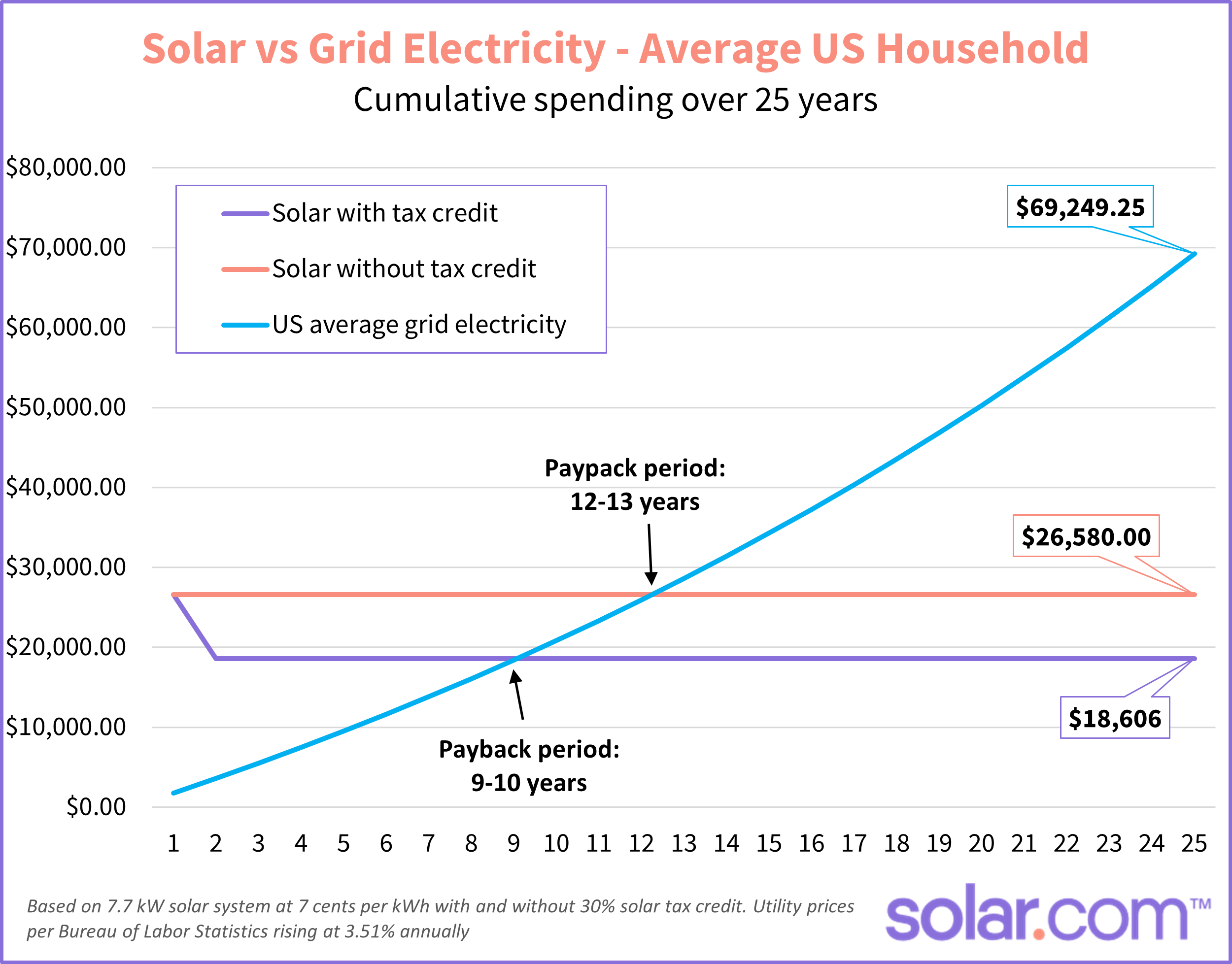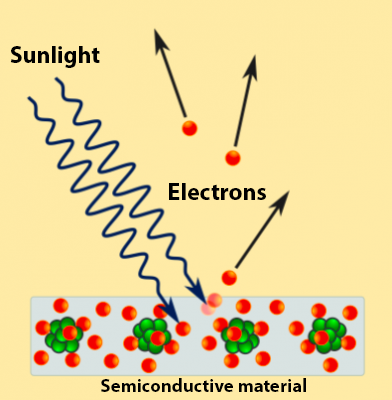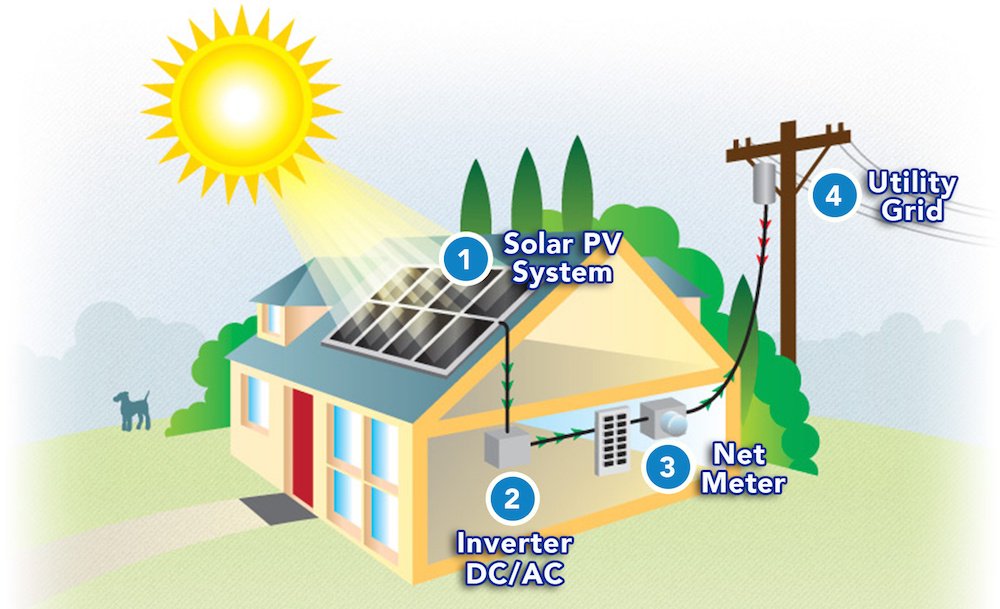
How long does it take for solar panels to pay for themselves?
The amount of time it takes for the energy savings to exceed the cost of installing solar panels is know as the payback period or break-even period. A typical payback period for residential solar is 7-10 years, althought it varies depending on your utility rates, incentives, system size, and other factors.
Everybody’s solar payback period is different based on their unique circumstances. So in this article, we’ll explore:
- What is a good payback period?
- The factors that influence your break-even point
- How to calculate your payback period
- How to account for energy inflation
Let’s jump right in by exploring what counts as a good solar payback period.
What is a good payback period for solar panels?
The average payback period for solar panels is 7-10 years – which is pretty good considering solar panels are warrantied for 25 years and can last much longer. That leaves around two-thirds of the warranty period – 15-18 years – to accumulate energy savings.
But the payback period can vary quite a bit from homeowner to homeowner. Based on real quotes presented to solar.com customers, some solar projects have a payback period under 3 years while for others it’s closer to 12.
Even at the high end, a 12-year payback period still leaves more than half of the system’s warrantied life left to accumulate energy savings.
What if I move before my payback period?
One downside of solar panels is that you can’t take them with you if you move. However, it’s well documented by Zillow and Berkeley Lab that solar panels increase your home value.
So even if you move before your payback period, you will likely recoup the cost of installing your solar panels, if not a little more.
What influences your solar payback period?
The payback period for solar panels is different for every homeowner. There are four main factors that influence your payback period, beginning with the total cost of your solar system.
Gross solar system cost
The gross cost of a solar system depends on:
- Its size (in kWh)
- The cost of the equipment installed
- The installation company
- Your financing methods (cash vs solar loan)
One way to think of the gross cost of a solar system is that you’re buying 25-years worth of solar electricity once. There’s going to be some sticker shock, but when you break the cost down to years, months, days, and kilowatt hours, it is much cheaper than paying for grid electricity.
It gets even cheaper when you factor in tax credits, rebates, and other incentives.
Tax credits, rebates, and other incentives
Solar incentives like the 30% federal tax credit and state rebates can be used to bring down the upfront cost of going solar and shorten your payback period.
Here’s how that looks for the average American homeowner looking to completely offset their electricity bill.

Without the 30% solar tax credit, the average homeowner is looking at a payback period of 12-13 years. But claiming the solar tax credit reduces that payback period to 9-10 years, and adds nearly $8,000 to their energy savings.
Here are some solar incentives to look into:
- Federal solar tax credit
- State solar tax credits and rebates
- Sales and property tax exemptions
- County, city, and utility rebates
- Solar Renewable Energy Credits (SRECS) and similar programs
Utility electricity price
One of the biggest factors in determining the payback period of solar panels is your grid electricity price. The higher the price, the shorter your payback period.
As of July 2023, the national average price for grid electricity was 16.9 cents per kWh. Meanwhile, the average price for solar panels purchased through solar.com is around 7 cents per kWh.
The price of grid electricity varies widely across the US. The table below shows the relationship between utility prices and the break even point of going solar.
Estimated payback period of solar panels for major US metros
| Location | May 2023 grid price (cents per kWh) | Estimated average payback period* |
| National average | 16.9 | 9-10 years |
| New York City metro | 25.1 | 7-8 years |
| Minneapolis metro | 19.1 | 9-10 years |
| Houston metro | 15.7 | 7-8 years |
| San Francisco metro | 34.9 | 4-5 years |
| San Diego metro | 47.5 | 3-4 years |
*Based on 7.7 kW solar system at net cost of $18,606 after claiming 30% solar tax credit versus October 2022 utility prices rising at 3.51% annually, per BLS.
How to calculate the payback period of solar panels
The easiest and most accurate way to calculate the payback period of solar panels is by getting multiple quotes from vetted local installers, which you can do right here on solar.com.
But if you want to get a ballpark estimate on your own, here’s the formula for calculating your payback period.
Payback period = Net Cost of Going Solar / Annual Energy Savings
Let’s go through an example to see how this equation plays out.
Net cost of going solar
What it is: The total cost of going solar after factoring in tax credits, rebates, and other incentives
How to find it: Get multiple quotes from vetted local installers.
Example scenario: Let’s say the gross cost of your solar system is $24,000. The 30% federal tax credit alone brings the net cost down to $16,800.
State, local, and utility incentives could bring the net cost down even further. But for the purposes of our example, we’ll stick with $16,800.
Annual energy savings
What it is: Your electricity costs before going solar. Once you go solar, this cost becomes savings because you’re no longer paying for electricity!
How to find it: Dig up a year’s worth of your most recent electricity bills and add them together. Or, if you can only find a handful of bills, average the monthly cost and multiply by 12 to find your annual cost.
Example scenario: The average American household uses around 10,000 kWh of electricity per year and pays 16.7 cents per kWh for that electricity. So for our example, we’ll use $1,670 as the annual energy savings.
Payback period
Now that we have our net cost of going solar and annual energy savings, we can calculate the payback period of going solar.
$16,800 / $1,670 = 10.05 years
Hold on, didn’t we say the average payback period of solar panels is 7-10 years?
Well, there’s one more important factor to account for: Inflation.
Factoring inflation into your solar payback period
Electricity prices are subject to inflation and have been rising at an average annual rate of 3.5% over the last 5 years, according to the Bureau of Labor Statistics. To account for this, we need to increase the annual energy savings by 3.5% every year, which shortens the payback period of solar panels.
Here’s how that looks over 25 years:
| Year | Annual energy savings without inflation | Annual energy savings including inflation |
| 1 | $1,670 | $1,670 |
| 5 | $1,670 | $1,916.36 |
| 10 | $1,670 | $2,276.04 |
| 15 | $1,670 | $2,703.22 |
| 20 | $1,670 | $3,210.58 |
| 15 | $1,670 | $3,813.16 |
| Cumulative electricity cost over 25 years | $41,750 | $65,046 |
| Average annual cost over 25 years | $1,670 | $2,601.85 |
Now, here’s where things get tricky. Since $2,601 is the average for 25 years of utility payments, and we know the break even period is within 10.5 years, it wouldn’t be accurate to use that figure as our annual energy savings. After all, your annual energy savings wouldn’t hit $2,601 until year 13-14.
That’s where graphs come in handy. Below, you’ll see the rising cost of electricity costs charted against the flat cost of going solar. The lines cross between year 8-9, signifying a payback period around 8.5 years – right in the meat of the 7-10 year average.

Again, the easiest and most accurate way to find the payback period of solar panels is to get multiple binding solar quotes. Get started here.
Going solar pays off – the only question is when you’ll break even
To recap, the average payback period for solar panels is 7-10 years, but can vary depending on your solar costs, electricity rate, and available incentives.
To get a rough estimate of your solar payback period, divide the net cost of going solar by your annual savings (your current electricity costs). However, the math gets more complicated – and accurate – when you factor in the ever-rising cost of energy.
Finally, even if you move before your break-even point, your solar panels will likely pay for themselves through additional home value.
Start your solar journey here with multiple quotes from vetted installers.




